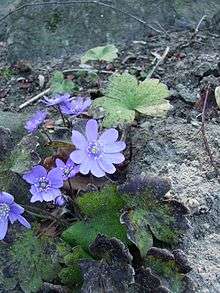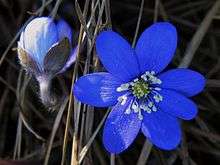Hepatica
| Hepatica | |
|---|---|
| | |
| Hepatica nobilis | |
| Scientific classification | |
| Kingdom: | Plantae |
| (unranked): | Angiosperms |
| (unranked): | Eudicots |
| Order: | Ranunculales |
| Family: | Ranunculaceae |
| Genus: | Hepatica Mill. |
| Species | |
|
See text. | |

Hepatica (hepatica,[1] liverleaf,[2] or liverwort)[3] is a genus of herbaceous perennials in the buttercup family, native to central and northern Europe, Asia and eastern North America. Some botanists include Hepatica within a wider interpretation of Anemone.[4][5]
Etymology
The word hepatica derives from the Latin hepaticus (liver), because the three-lobed leaf was thought to resemble the human liver.[6]
Description
Bisexual flowers with pink, purple, blue, or white sepals and three green bracts appear singly on hairy stems from late winter to spring. Butterflies, moths, bees, flies and beetles are known pollinators.
The leaves are basal, leathery, and usually three-lobed, remaining over winter.
Cultivation
Hepatica cultivation has been popular in Japan since the 18th century (mid-Edo period), where flowers with doubled petals and a range of colour patterns have been developed.[7]
Noted for its tolerance of alkaline limestone-derived soils, Hepatica may grow in a wide range of conditions; it can be found either in deeply shaded deciduous (especially beech) woodland and scrub or grassland in full sun. Hepatica will also grow in both sandy and clay-rich substrates, being associated with limestone. Moist soil and winter snowfall is a requirement; Hepatica is tolerant of winter snow cover, but less so of dry frost.
Propagation
Propagation is done by seeds or by dividing vigorous clumps in spring. However, seedlings take several years to reach bloom size, and divided plants are slow to thicken.
Herbalism
Hepatica is named from its leaves, which, like the human liver (Greek hepar), have three lobes. It was once used as a medicinal herb. Owing to the doctrine of signatures, the plant was once thought to be an effective treatment for liver disorders. Although poisonous in large doses, the leaves and flowers may be used as an astringent, as a demulcent for slow-healing injuries, and as a diuretic.[4]
Species


Between one and ten species of Hepatica are recognised, with some of the taxa more often treated as varieties:
- Hepatica nobilis = common hepatica[8]
- Europe
- Hepatica nobilis var. pyrenaica = Hepatica pyrenaica Pyrenees
- Hepatica nobilis var. nobilis European Hepatica — Scandinavia to Alps
- Japan
- Eastern North America [9][10]
- Hepatica nobilis var. acuta = Hepatica acutiloba, Anemone acutiloba,[11][12] Sharp-lobed Hepatica[13][14]
- Hepatica nobilis var. obtusa = Hepatica americana, Anemone americana,[12][15] Round-lobed hepatica
- Hepatica transsilvanica = Anemone transsilvanica (Fuss) Heuff.[8] Carpathian Mountains, Transylvania
References
- ↑ Gleason, H.A. 1952. The new Britton and Brown Illustrated flora of the Northeastern United States and adjacent Canada. Volume 2: The chloripetalous Dicotyledoneae. Hafner Press, New York.
- ↑ Bailey, L.H.; Bailey, E.Z.; the staff of the Liberty Hyde Bailey Hortorium. 1976. Hortus third: A concise dictionary of plants cultivated in the United States and Canada. Macmillan, New York.
- ↑ Webster's Third International Dictionary
- 1 2 John Uri Lloyd; Curtis G. Lloyd (1884–1887). "Drugs and medicines of North America: Hepatica".
- ↑ Sara B. Hoot; Anton A. Reznicek; Jeffrey D. Palmer (Jan–Mar 1994). "Phylogenetic Relationships in Anemone (Ranunculaceae) Based on Morphology and Chloroplast DNA". Systematic Botany. 19 (1): 169–200. doi:10.2307/2419720. JSTOR 2419720.
- ↑ Shorter Oxford English dictionary. United Kingdom: Oxford University Press. 2007. p. 3804. ISBN 0199206872.
- ↑ Jon Ardle (2000). "Layers of Complexity". The Garden. Royal Horticultural Society.
- 1 2 3 4 "The Plant List: A Working List of all Plant Species".
- ↑ Slattery, Britt E., Kathryn Reshetiloff, and Susan M. Zwicker (2003). "Hepatica nobilis var. obtusa". Native Plants for Wildlife Habitat and Conservation Landscaping: Chesapeake Bay Watershed.
- ↑ "Taxonomic Serial No.: 528379". Integrated Taxonomic Information System.
- ↑ "Anemone acutiloba (de Candolle) G. Lawson". Flora of North America.
- 1 2 Alan S. Weakley (April 2008). "Flora of the Carolinas, Virginia, and Georgia, and Surrounding Areas".
- ↑ Slattery, Britt E., Kathryn Reshetiloff, and Susan M. Zwicker (2003). "Hepatica nobilis var. acuta". Native Plants for Wildlife Habitat and Conservation Landscaping: Chesapeake Bay Watershed.
- ↑ "Taxonomic Serial No.: 528378". Integrated Taxonomic Information System.
- ↑ "Anemone americana (de Candolle) H. Hara". Flora of North America.